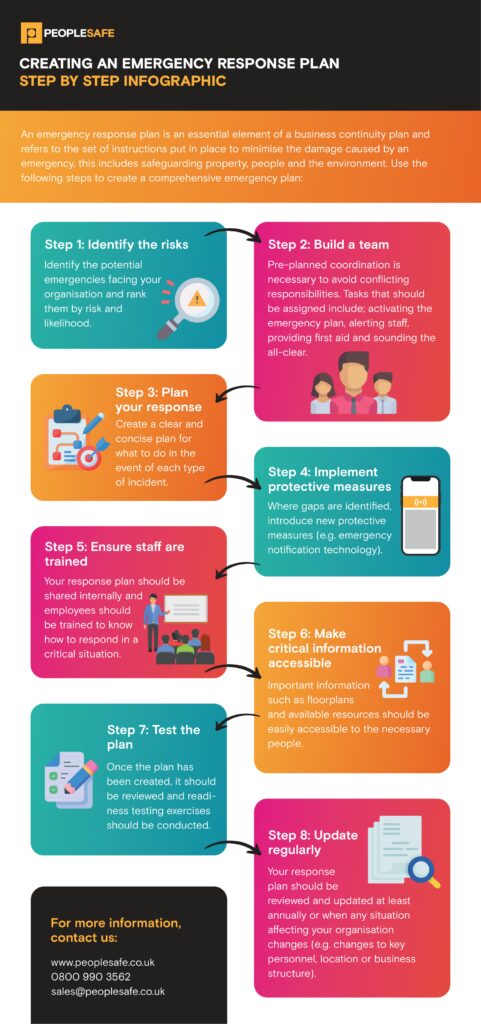Emergency Planning in the Workplace
Emergencies can happen anywhere and at any time, and the steps taken in the immediate aftermath of a crisis event can determine how severe the impact is. When an emergency breaks out, lots of decisions need to be made in a short period of time, and often the normal chain of command is not available. The added stress of the situation can also lead to poor decision making or oversights being made.
Preparing for all eventualities is an important element of business continuity planning and compliance with Business Continuity Management Standard ISO 22301.
What is emergency preparedness?
Emergency preparedness is a state of readiness which enables organisations involved in an emergency to mobilise, organise and provide relief measures to deal with the impacts of the disaster. This involves undertaking a continuous cycle of planning, organising, training, equipping, evaluating and taking action to ensure effective coordination in the event of an incident. With this in mind, organisations should plan ahead, consider the actions they would need to take in a crisis and create an emergency response plan to follow.
What is an emergency response plan?
An emergency response plan is an essential element of a business continuity plan and refers to the set of instructions put in place to minimise the damage caused by an emergency, this includes safeguarding property, people and the environment. Typically, emergency response plans cover situations such as;
- medical emergencies,
- terrorist attacks,
- fires,
- natural disasters,
- pandemics, and
- power failures.
Having a response plan in place is vital as it minimises the probability of significant damages and allows for business as usual to recommence as soon as possible. This further reduces the impact on stakeholders and protects the reputation of the organisation.
Aside from providing guidance for crisis situations, emergency planning can help organisations to identify gaps in their existing procedures and risk assessments. This then allows time to amend these procedures and implement the necessary steps before an emergency occurs.
How to create an emergency response plan
All organisations have a responsibility to follow health and safety legislation which requires businesses to identify and mitigate any risk to their employees. Additionally, organisations in the health system (emergency services, local authorities, NHS) are required to prepare for adverse events under The Civil Contingencies Act 2004.
In general, all emergency response plans should include the following:
- Details of resources available in an emergency
- Detailed lists of emergency response personnel including their phone numbers, alternate contact details, and their duties and responsibilities
- Floor plans
- Maps showing evacuation routes and service conduits (such as gas and water lines)
Types of emergency
The HSE advises that the responses in your plan should be proportionate to the level of risk presented and the potential extent and severity of the incident, so the first step in creating your emergency response plan should be to identify the potential risks.
Crisis events come in all shapes and sizes, and will have varying degrees of impact on businesses and their workforces. These different events therefore require different specific responses and have varying degrees of urgency, so it’s important to know how to deal with each scenario effectively. As a general rule, emergencies can be split into 3 categories:
- Natural emergencies include natural disasters, such as floods, hurricanes and fires. These can occur at any time and may have logistical impacts on your organisation.
- Civil emergencies include strikes, protests and harassment at the workplace. These can occur outside of your organisation or may directly involve members of your team.
- Work-related emergencies occur as a result of factors related to the workplace. These emergencies include chemical spills, machinery malfunctions and gas leaks.
Co-ordinating an emergency response
Pre-planned coordination is necessary to avoid conflicting responsibilities. This is why pre-determining the chain of command and assigning responsibilities is so important. As the normal chain of command isn’t always available, backup personnel who can be available on short notice should be included where possible and at least one person who is able to implement the emergency response plan should be available at all times. Some of the specific duties that should be assigned are:
- Activating the emergency plan
- Alerting staff
- Providing first aid
- Managing site evacuations
- Advising relatives where needed
- Alerting key stakeholders
- Sounding the all-clear
Communicating in an emergency
During any crisis event, it’s crucial for employers to alert, protect and reassure their employees with fast, accurate information. Effective crisis communication boils down to saying the right things to the right people at the right time. In the BCI Emergency Communications Report 2022, 25.7% of organisations said that communicating with staff was their primary challenge during an incident. This highlights the importance of knowing how you will communicate with staff in an emergency.
Disseminating information during emergency situations via social media, emails or other unsuitable tools can cause significant damage. In today’s society where we are all constantly connected, it is easy to become desensitised to alerts, messages and notifications, which can mean that important information gets missed. With no way to report on who has received and read your message, it’s also impossible to know if staff are aware of the situation.
As a result, an increasing number of organisations are turning to specialist tools. In the 2022 BCI Emergency and Crisis Communications Report, 63.5% of people responsible for emergency planning said that they are now using specialist tools and software to communicate with staff in critical situations. The most common area where organisations required support was in ‘alerting and mobilising large numbers in a short time’, with 71.5% of those with tools in place claiming that this was its main function.

Promote and maintain the plan
It’s not enough to just have an emergency response plan, organisations should also work to promote this internally and ensure employees are trained to know what to do in a critical situation. Instilling a sense of confidence in your staff that they know how to react regardless of the situation is priceless when seconds count.
Promoting an emergency response plan will not only ensure safety procedures are followed in an emergency, but it will also reassure staff that you value their safety. This in turn can put your employees at ease and allow them to be more productive and happier at work.
Review and update the plan
To ensure your emergency response plan is, and remains thorough, it is recommended to run readiness testing exercises at least annually or when any situation affecting your organisation changes (e.g., changes to key personnel, location or business structure). A readiness test should evaluate all critical elements of the plan and may also review other specific components. After each test, a review should be conducted to identify any areas that require improvement.
Emergency planning technology
Specialist tools such as Peoplesafe Alert, our emergency alert system enables your business to be compliant with ISO 22301 and allow for more effective communication in an emergency.
This service has the ability to override a device’s silent or do not disturb settings, making sure that your staff receive and read critical messages, no matter the time. Additionally, messages can be sent with repeat reminders; this means that the message will continue to be sent every 20 seconds until the recipient has acknowledged that they have read it or completed the required response.
Administrators and managers can audit communications and report on this information to boost compliance and deliver peace of mind that those who need to be informed, are aware of the situation.
Learn more about Peoplesafe Alert







